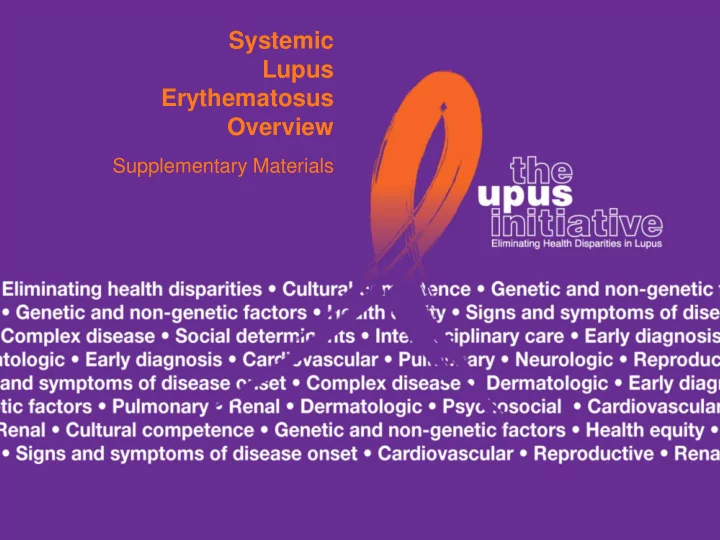

Systemic Lupus Erythematosus Overview Supplementary Materials
Autoantibodies • Natural autoantibodies effectively clear cellular debris (IgM) in healthy individuals • Pathogenic autoantibodies: – IgG – Form immune complexes – Directly target cells through cross-reactivity with other antigens. For example, subsets of anti-dsDNA antibodies bind NMDA receptors on neurons or components of the basement membrane in renal glomeruli
Beneficial Autoantibodies Natural Cleared by natural autoantibody; IgM IgM, complement, DNAse and SAP Apoptotic DNA particle Deficiencies cause SLE Pathogenic Autoantibodies: anti-dsDNA Hahn HB. N Engl J Med . 1998;338:1359-1368.
Complement Activation Chen M, Daha MR, Kallenberg CG. J Autoimmun . 2010;34:J276-J286.
DNA-Containing Immune Complexes Activate Dendritic Cells and Autoreactive B-Cells FCR Plasmacytoid DC IgG immune TLR complexes Type I IFN Cytokines Autoantibodies BCR Myeloid DC B-cell TLR Antigen presentation Costimulation Cytokines Proliferation T Cell and memory IgM immune complexes do not activate DCs or B-cells
Immune Dysregulation — T-Cells • Activated T-cells provide support to autoreactive B-cells and facilitate autoantibody production • SLE patients exhibit increased numbers of Th17 and Th cells and decreased numbers of Tregs • Lupus T-cells are less susceptible to activation- induced cell death • Alterations in the TCR complex (the TCR ζ chain) lead to changes in intracellular signaling that result in increased expression of CD40L and decreased production of IL-2
Immune Dysregulation — Plasmacytoid Dendritic Cells • Activated plasmacytoid dendritic cells (pDC) – Produce large amounts of IFN- α – Stimulate activation and proliferation of autoreactive T- and B-cells – Different types of DCs activate different T-cell subsets; Th1, Th2, Th17, and Treg (dependent on cytokine milieu)
Signs and Symptoms Symptoms Occurrence (ever) Arthralgias 95% Neurologic 90% Fever >100 °F (38 °C) 90% Prolonged or extreme fatigue 81% Arthritis 80% Skin rashes 74% Anemia 71% Kidney involvement 50% Pleurisy and/or pericarditis 45% Butterfly-shaped rash across the cheeks and nose 42% Sun or light sensitivity (photosensitivity) 30% Hair loss 27% Abnormal blood clotting problems 20% Raynaud’s phenomenon 17% Seizures 15% Mouth or nose ulcers 12%
Autoimmunity — Jigsaw Model Current proposal: Altered immune homeostasis leads to simultaneous autoreactivity, immunodeficiency, and malignancy
Bibliography
Slide 3 Reference Hahn HB. Antibodies to DNA. N Engl J Med . 1998;338:1359-1368. Slide 4 Reference Chen M, Daha MR, Kallenberg CG. The complement system in systemic autoimmune disease. J Autoimmun . 2010;34:J276-J286.
Recommend
More recommend